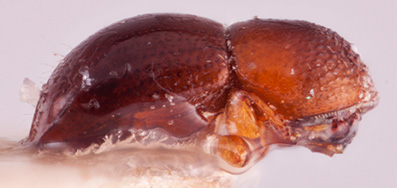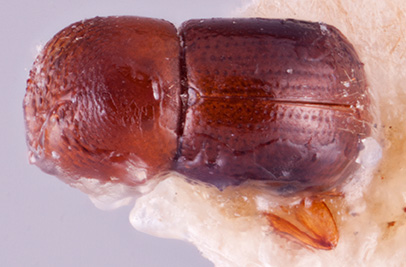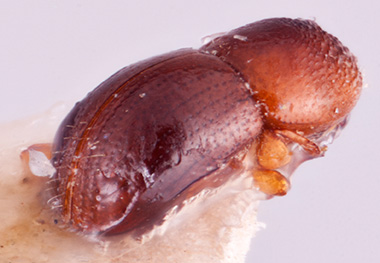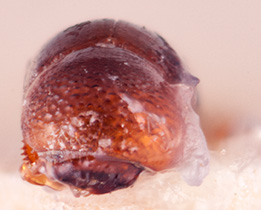Xylosandrus metagermanus
|
Xylosandrus metagermanus holotype lateral; R.K. Osborn |
|
Xylosandrus metagermanus holotype dorsal; R.K. Osborn |
|
Xylosandrus metagermanus holotype declivity; R.K. Osborn |
|
Xylosandrus metagermanus holotype frontal; R.K. Osborn |
Taxonomic history
Xyleborus metagermanus Schedl, 1951a: 58.
Xylosandrus metagermanus (Schedl): Browne, 1963: 55.
Diagnosis
1.8−2.3 mm long (mean = 2.05 mm; n = 2); 2.09−2.25 times as long as wide. This species can be distinguished by its small size; elytralelytral:
'pertaining to the elytra
discdisc:
the flat central upper surface of any body part (e.g. pronotum and elytra) gradually curving toward declivitydeclivity:
gradually curving toward declivitydeclivity:
downward slope of either the pronotum or elytra
 , appearing rounded; posterolateralposterolateral:
, appearing rounded; posterolateralposterolateral:
'relating to end of the side part/portion
 margins of elytraelytron:
margins of elytraelytron:
'
the two sclerotized forewings of beetles that protect and cover the flight wings
carinate to interstriaeinterstria:
'longitudinal spaces along the elytra between the striae, which is not as<br />
impressed and bear smaller punctures.
 7; declivitaldeclivital:
7; declivitaldeclivital:
pertaining to the elytral declivity
face with six punctatepunctate:
'set with fine impressed points, appearing as pin pricks
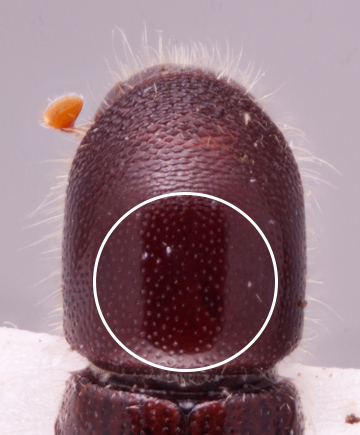 and clearly impressedimpressed:
and clearly impressedimpressed:
'a depression in a surface
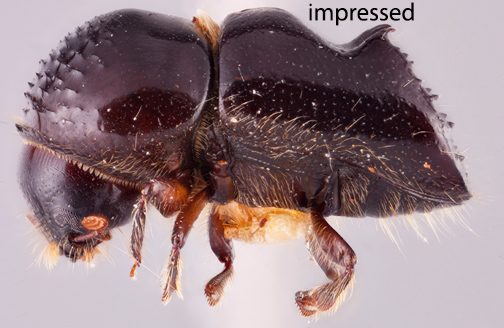 striae; declivitaldeclivital:
striae; declivitaldeclivital:
pertaining to the elytral declivity
interstriae granulategranulate:
'pertaining to a coarse, grainy surface texture'
 , uniseriate with erecterect:
, uniseriate with erecterect:
'pertaining to setae that have their apices directed away from the body and appear straight
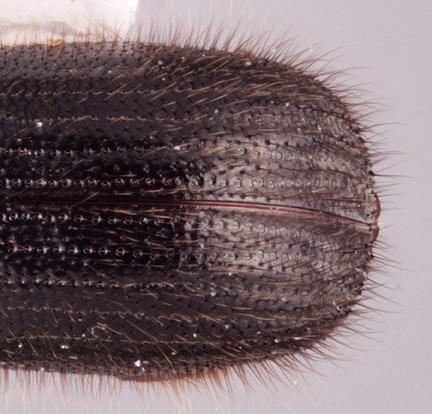 hair-like setaeseta:
hair-like setaeseta:
small hair-like or scale-like structure
longer 1−1.5 times the width of an interstriae; pronotumpronotum:
'the dorsal surface of the thorax
1.1 times long as wide, pronotumpronotum:
'the dorsal surface of the thorax
from dorsaldorsal:
'of or relating to the upper surface; opposite of ventral
 view rounded (type 1) and laterallateral:
view rounded (type 1) and laterallateral:
'pertaining to the side
 view basic (type 0), summitsummit:
view basic (type 0), summitsummit:
highest point, used for pronotum and elytra, denotes the peak between pronotal frontal slope and disc, and between elytral disc and declivity at midpoint, basalbase:
at midpoint, basalbase:
point or edge closest to the body; opposite of apex half smooth, shiningshining:
half smooth, shiningshining:
appearing glossy or bright in luster; referring to a surface that is polished and reflects light well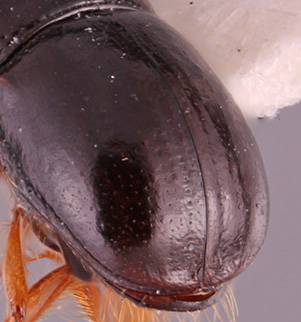 , sparsely minutely punctatepunctate:
, sparsely minutely punctatepunctate:
'set with fine impressed points, appearing as pin pricks
 ; and sparse mycangial tuftmycangial tuft:
; and sparse mycangial tuftmycangial tuft:
'tuft of setae that denotes the mycangia exterior opening
 on the pronotalpronotal:
on the pronotalpronotal:
'pertaining to the pronotum
basebase:
point or edge closest to the body; opposite of apex .
.
This species is very similar to X. germanus and is most easily distinguished by the larger, deeper strial punctures and clearly impressedimpressed:
'a depression in a surface
 striae.
striae.
May be confused with
Anisandrus dispar, A. maiche, A. paragogus, Xylosandrus dentipennis, X. eupatorii, and X. germanus
Distribution
India (Assam)
Host plants
recorded only from Gmelina (Lamiaceae) (Schedl 1951aSchedl 1951a:
Schedl KE. 1951a. Fauna Indomalayaensis, I. Tijdschrift voor Entomologie 93: 41-98. https://doi.org/10.1080/00222935008654721)
DNA data
specimens not available for sequencing

